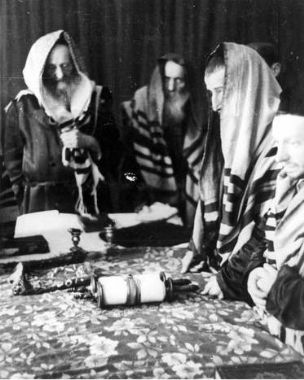The Rabbi Isaac Elchanan Theological Seminary’s Small Torah, New York
By: Yaakov Rosenfeld
Hoshana Raba 5702 (1941), Radovic (Bukovina)
At the train station, hundreds of cars stood by, swallowing up thousands of Jews who were brutally expelled from their homes by the Nazis.
About 15,000 Jews stood crammed inside the cars, waiting to move, and once the train started moving, it didn’t stop for a single moment. The overcrowding was terrible and the suffocation unbearable; this is how they traveled day and night, each one immersed in himself, although surrounded by family members. Despair gnawed at their hearts and deathly silence surrounds the space in the stinking cars.
Suddenly a muffled voice was heard.
“Jews, it is Simchat Torah today!”
The Jew who was standing huddled in one of the cars, took out a tiny Torah scroll and began to dance in circles. And here, a refreshing gust of Jewish joy burst into the train. The Torah passed from one to another and from one to another. Thousands of Jews danced laps with the Torah book throughout the day, forgot the sorrow and worry, ignored the death and the stench. In a loud voice, the Jews sang “Blessed is our G-d who created us for His glory and distinguished us from those who stray, and gave us the true Torah.”
Faith and hope of a stubborn nation, inside cars full of dead and dying Jews. Many of the passengers did not survive the journey and finally, at the end of the long torturous trup, the Jews were forced off with brutal screams.
For six days, the thousands stayed in the city of Otik, near Mohilev, where the Nazis had already massacred the city’s Jews and housed a very large population of mentally ill people in various states. This is how thousands of people found themselves, destitute, in a city full of mentally ill people. From there, they were transported in rafts on the Dniester to Mohilev, a ghost town whose Jews had long since been deported to their deaths.
The Jews walked around Mohilev and were busy burying the dead.
Rabbi Aharon Twersky was also one of the Radovic expellees who lived in Mohilev.
His father, the the holy Rebbe, Rabbi Yitzchak Twersky from Ozarnitz, of the Chernobyl chassidic dynasty, was killed in sanctification of G-d’s Name a year prior in the city of Beltz (Balti). The Nazis tied him to to a tree while he was wrapped in a tallis (prayershawl) and in front of Jews who stood around him and were forced to clap their hands in “joy,” they tore off his beard and sidelocks and tortured him to death.
One day, when Rabbi Aharon Twersky was digging in the ground to bury a dead person, he found a small Torah lying there. His heart skipped a beat with excitement.

Jews during the reading of the Torah in a synagogue organized in the Warsaw ghetto, Poland. A small Torah scroll is placed on the makeshift bima (prayer platform).
He buried the dead person in that spot, and he buried the Torah in a secret place, and in his heart he made a vow: If God takes me out of this land alive, and I will merit to survive, I will rescue the Torah from here and take it with me.
Rabbi Aharon merited, and after much grief and torture he survived the war, almost the only one of the whole family, and immigrated to the United States but not before travelling, with great effort to Mohilev, and thank G-d, he remembered the hiding place. He dug and took out the precious treasure, taking it with him on the long road to the land of freedom, and to this day it is in the magnificent ark of the Rabbi Isaac Elchanan Theological Seminary (RIETS), where Rabbi Aharon studied and was appointed to the rabbinate.
(Based on the testimony given by Rabbi Aharon Twersky to the author, Rabbi Menashe Unger: Admorim Shenaspu BaShoah, Mossad HaRav Kook, Jerusalem 5767/2006-7 edition)












